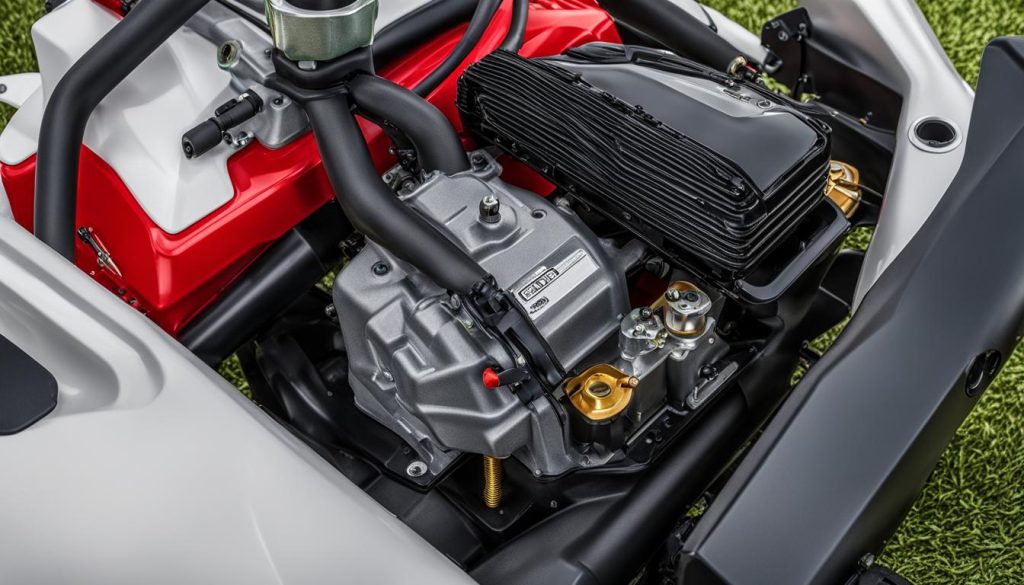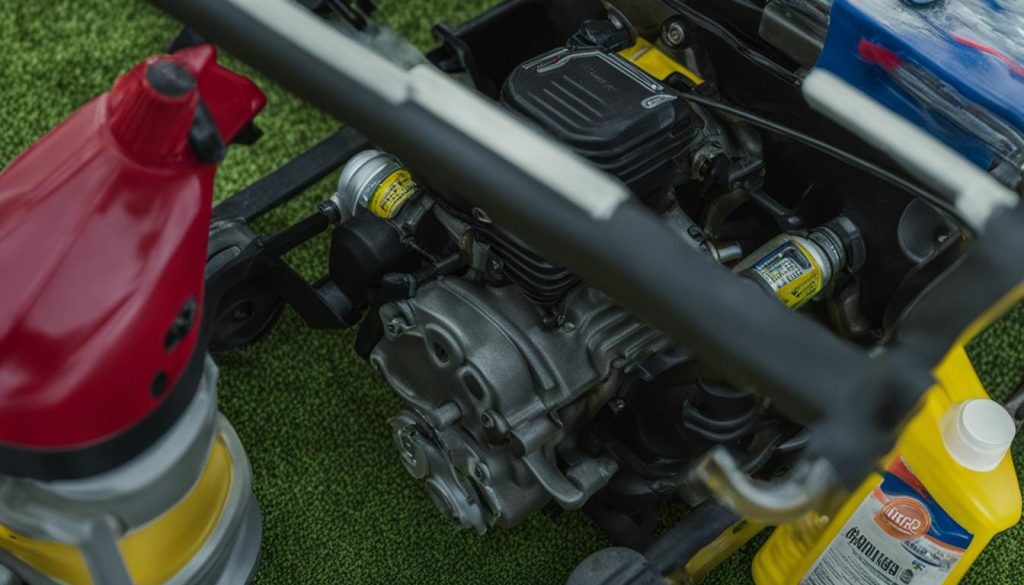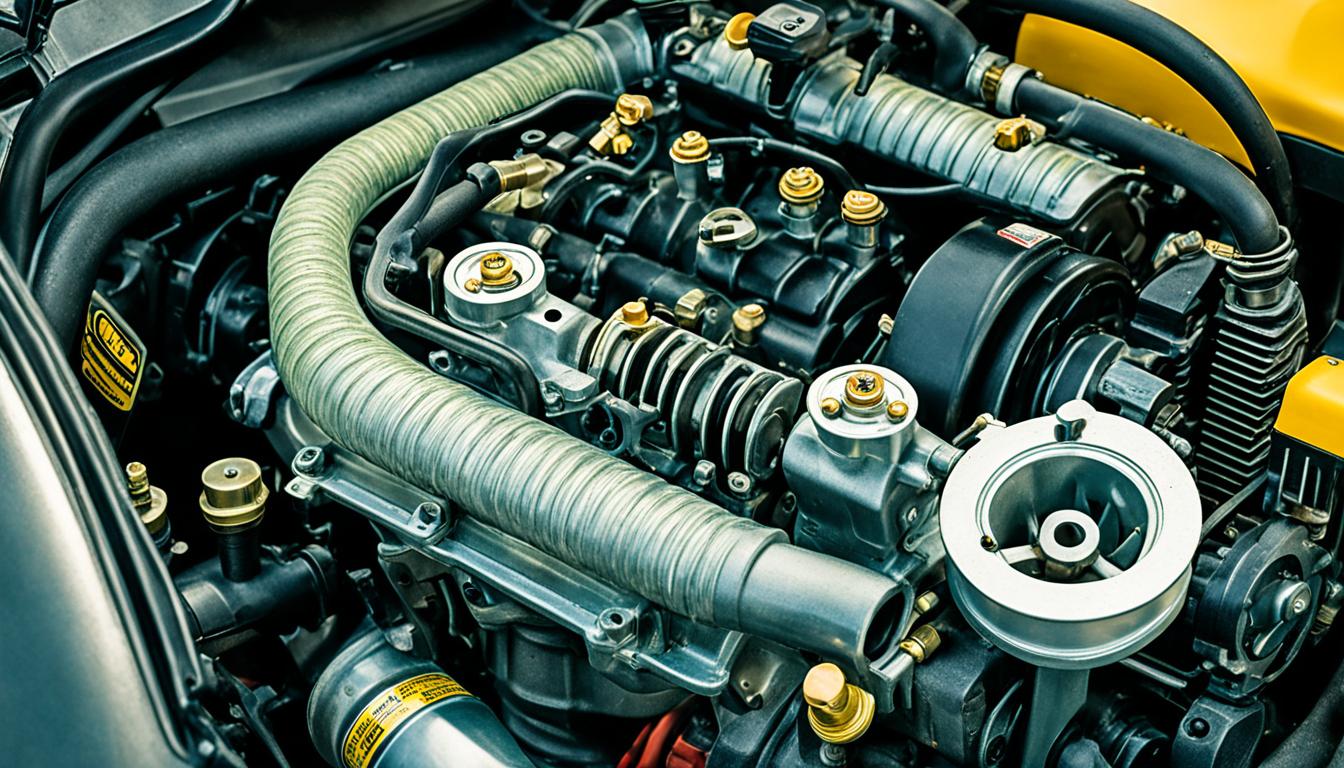When it comes to the inner workings of a lawn mower, one component that often mystifies owners is the carburetor. But do you know where it is located? Can you find it on your own? These questions may seem simple, but the answer is not always as obvious as you might think.
Understanding the location of the carburetor is crucial for maintaining and repairing your lawn mower. It plays a vital role in mixing fuel and air to ensure efficient engine performance. So, let’s dive in and discover the whereabouts of this essential component!
Key Takeaways:
- The carburetor on a lawn mower is responsible for mixing fuel and air.
- Knowing the location of the carburetor is essential for maintenance and repair purposes.
- It can be hidden behind the air filter and located on the side or top of the engine.
- Regular carburetor maintenance is crucial for optimal lawn mower performance.
- A clean and well-maintained carburetor ensures the proper fuel-air mixture.
Why is carburetor maintenance important?
Regular carburetor maintenance is crucial for the overall health and performance of your lawn mower. A well-maintained carburetor ensures the proper balance of fuel and air, leading to efficient operation and a longer lifespan for your equipment.
Without proper maintenance, the carburetor can become clogged or damaged, resulting in poor engine performance and decreased fuel efficiency. Over time, dirt, debris, and varnish can accumulate in the carburetor, obstructing the flow of fuel and hindering the combustion process.
By regularly cleaning and maintaining the carburetor, you can prevent these issues and keep your lawn mower running smoothly. A clean carburetor allows for the correct fuel-to-air ratio, ensuring optimal combustion and maximum power output. This not only improves the performance of your lawn mower but also reduces emissions and helps contribute to a cleaner environment.
Proper carburetor maintenance also helps to identify potential problems early on. By inspecting the carburetor regularly, you can spot any signs of wear, damage, or misalignment, allowing for timely repairs or replacements.
In addition, maintaining the carburetor ensures that your lawn mower is always ready for use. A well-functioning carburetor reduces the likelihood of unexpected breakdowns or engine failures, saving you time, effort, and money on repairs.
Overall, keeping your carburetor in good condition is essential for the reliable performance of your lawn mower. Regular maintenance not only ensures efficient operation but also extends the life of your equipment, allowing you to enjoy a well-groomed lawn year after year.
How to locate the carburetor on a push/walk-behind mower?
When it comes to push or walk-behind mowers, finding the carburetor is essential for maintenance and repair. The carburetor is responsible for mixing fuel and air to ensure the engine runs smoothly and efficiently. Follow these steps to locate the carburetor on your push/walk-behind mower:
- Step 1: Start by locating the air filter on your mower. The air filter is usually located on the side or top of the engine.
- Step 2: Once you’ve located the air filter, you’ll find the carburetor positioned behind it. The carburetor is typically a silver and black component made mostly of metal.
- Step 3: To access the carburetor, you’ll need to remove the air filter. Gently lift the air filter housing and set it aside.
- Step 4: With the air filter removed, you’ll now have a clear view of the carburetor. Take note of its position for future reference.
Remember to exercise caution when working around the carburetor and other engine components. Proper maintenance and regular cleaning of the carburetor can help ensure optimal performance and extend the lifespan of your push/walk-behind mower.
| Carburetor Location | Push/Walk-Behind Mower |
|---|---|
| Position | Side or top of the engine |
| Location relative to air filter | Behind the air filter |
| Appearance | Silver and black component made mostly of metal |
| Step-by-step access | 1. Locate the air filter 2. Find the carburetor behind the air filter 3. Remove the air filter to access the carburetor 4. Take note of its position |
How to locate the carburetor on a riding mower?
When it comes to riding mowers or lawn tractors, knowing the location of the carburetor is essential for maintenance and repairs. The carburetor on a riding mower is typically found on the side or top of the engine.
To access the carburetor, you will need to remove the air filter and the filter housing. The carburetor is usually located behind the air filter, so taking these steps will allow you to reach it easily.
Additionally, it’s important to note that the carburetor is connected to the gas tank by a fuel line. This connection ensures a steady supply of fuel to the carburetor, which is crucial for the proper functioning of the engine.

By familiarizing yourself with the riding mower carburetor location, you’ll be able to perform necessary maintenance tasks, such as cleaning or adjusting the carburetor, with ease. Regular maintenance will help keep your riding mower running smoothly and extend its lifespan.
Importance of carburetor maintenance for a lawn mower
Maintaining your lawn mower’s carburetor is essential for ensuring reliable and efficient operation. By keeping the carburetor clean and well-maintained, you can enjoy the benefits of a smoothly running engine and optimal fuel efficiency.
The carburetor plays a crucial role in the functioning of your lawn mower. It is responsible for mixing the fuel and air to create the proper fuel-air mixture needed for the combustion process. When the carburetor is dirty or clogged, it can negatively impact the performance of your mower and lead to issues such as difficulty starting, engine stalling, and increased fuel consumption.
Regular maintenance of the carburetor ensures that it remains clean and free from debris. This enables the carburetor to function optimally, providing the correct amount of fuel and air mixture for efficient combustion. With a clean carburetor, you can expect smoother starts, consistent engine performance, and improved fuel efficiency.
Proper carburetor maintenance also extends the lifespan of your lawn mower. By keeping the carburetor clean and well-maintained, you can prevent damage caused by clogs and debris buildup. This helps to avoid costly repairs or the need for replacement parts down the line.
| Benefits of Carburetor Maintenance for a Lawn Mower |
|---|
| 1. Smooth starting |
| 2. Consistent engine performance |
| 3. Optimal fuel efficiency |
| 4. Extended lifespan of your lawn mower |
Regularly cleaning and maintaining the carburetor of your lawn mower is a simple yet effective way to keep your equipment running smoothly and efficiently. By investing a little time and effort into carburetor maintenance, you can ensure the reliable performance of your lawn mower and enjoy a well-maintained lawn.
Signs that your carburetor needs cleaning
If you’re experiencing issues with the performance of your lawn mower, it’s important to consider the condition of the carburetor. A dirty carburetor can cause a range of problems that can affect the engine’s operation. Here are some signs that indicate your carburetor may need cleaning:
- Difficulty starting the engine: If you find it hard to start your lawn mower or notice that it takes multiple attempts before the engine starts, a dirty carburetor could be the culprit. The buildup of dirt and debris can obstruct the flow of fuel, making it difficult for the engine to ignite.
- Engine stalling: If your lawn mower’s engine stalls frequently while in use, it could be a sign of a dirty carburetor. A clogged carburetor can disrupt the proper fuel-air mixture, causing the engine to stall unexpectedly.
- Spluttering or shaking during operation: When the carburetor becomes dirty, it can lead to irregular fuel flow. This can result in the engine spluttering, misfiring, or shaking while you’re mowing the lawn.
- Increased fuel consumption: If you notice that your lawn mower is consuming more fuel than usual, it may be due to a dirty carburetor. A carburetor that is not functioning optimally can cause the engine to run inefficiently, leading to higher fuel consumption.
If you observe any of these signs, it’s recommended to clean your carburetor to restore its proper functioning. A clean carburetor will ensure a smooth fuel-air mixture, leading to improved engine performance and overall efficiency.
How to clean and maintain the carburetor
Cleaning the carburetor annually is crucial for maintaining optimal performance of your lawn mower. Follow these steps to clean and maintain the carburetor yourself:
1. Clean the outside of the engine:
Start by removing any debris or dirt from the outside of the engine using a soft cloth or brush. This will prevent any dirt from entering the carburetor during the cleaning process.

Before accessing the carburetor, remove the air filter by unscrewing the cover and lifting it off. Additionally, locate the fuel valve near the carburetor and turn it off to prevent fuel from leaking.
3. Disassemble the carburetor:
Unfasten the carburetor by removing any screws or bolts that hold it in place. Take note of the position of any cables and bolts for reassembly later. Carefully detach the carburetor from the engine.
4. Clean the carburetor:
Use a specialized carburetor cleaner or WD-40 to clean the carburetor thoroughly. Spray the cleaner onto the various components of the carburetor and use a brush to scrub away any debris or built-up grime. Ensure all the small holes and passages on the carburetor are free of blockages.
5. Remove rust, if necessary:
If you notice any rust on the carburetor, gently sand it using fine-grit sandpaper. This will help remove the rust and restore the carburetor’s functionality.
6. Allow the carburetor to air dry:
After cleaning, allow the carburetor to air dry completely before reassembling and reinstalling it on the engine. This will ensure that no moisture remains, preventing any potential issues when the mower is next used.
7. Reassemble and reinstall the carburetor:
Carefully reassemble the carburetor, making sure to reconnect all cables and bolts in their original positions. Once reassembled, reinstall the carburetor onto the engine, securing it with the screws or bolts.
8. Test the mower:
After cleaning and reinstalling the carburetor, start the mower to ensure it is running smoothly. Monitor the engine’s performance and check for any improvements in starting, running, and fuel efficiency.
| Steps to Clean and Maintain the Carburetor | Description |
|---|---|
| Clean the outside of the engine | Remove dirt and debris from the engine’s exterior using a soft cloth or brush |
| Remove the air filter and turn off the fuel valve | Access the carburetor by removing the air filter and turning off the fuel valve |
| Disassemble the carburetor | Unfasten the carburetor and carefully detach it from the engine, noting the position of cables and bolts for reassembly |
| Clean the carburetor | Use a specialized cleaner or WD-40 to clean the carburetor and remove any debris or grime |
| Remove rust, if necessary | Gently sand any rust on the carburetor using fine-grit sandpaper |
| Allow the carburetor to air dry | Ensure the carburetor is completely dry before reassembling and reinstalling it |
| Reassemble and reinstall the carburetor | Reconnect all cables and bolts, then secure the carburetor back onto the engine |
| Test the mower | Start the mower and check for improvements in performance |
Safety tips for carburetor maintenance
When performing maintenance on your lawn mower carburetor, it is important to prioritize safety to avoid any accidents or mishaps. Taking the necessary precautions will help ensure a smooth and hassle-free maintenance process.
1. Wear Gloves
Before you begin working on the carburetor, consider wearing gloves to protect your hands from any sharp edges or potential fuel spills. Gloves will provide an extra layer of safety and prevent any injuries during the maintenance process.
2. Protect Your Work Area
It is essential to prepare your work area properly before starting carburetor maintenance. Make sure there are no flammable materials nearby and cover the work surface with a clean cloth to prevent any fuel spills. Keeping a clean and tidy work area will minimize the risk of accidents or damage.
3. Seek Professional Help if Unsure
If you are unsure about how to clean the carburetor yourself or lack the necessary knowledge and experience, it is recommended to seek professional help. An expert technician will be able to properly diagnose any issues and perform the required maintenance, ensuring the safety of both you and your equipment.
4. Consider Replacement or Further Examination
If, after cleaning the carburetor, you find that it still does not work reliably or is experiencing persistent issues, it may indicate a more significant problem. In such cases, it is advisable to consider replacing the carburetor or having it further examined by a professional to identify and address any underlying issues.
By following these safety tips, you can ensure a safe and effective carburetor maintenance process for your lawn mower, promoting the longevity and efficient performance of your equipment.
Note: The image is used for illustrative purposes and does not depict a specific safety precaution.
Conclusion
Properly maintaining the carburetor on your lawn mower is essential for optimal performance and longevity. Regular maintenance ensures that the carburetor remains clean and functions efficiently, resulting in a clean fuel-air mixture. This, in turn, prevents common carburetor-related issues and promotes the smooth operation of your lawn mower.
Knowing the location of the carburetor on your lawn mower is crucial for easy access and regular cleaning. By regularly cleaning the carburetor, you can prevent fuel blockages and maintain the proper fuel-air ratio, which is vital for the overall health and performance of your machine.
By prioritizing carburetor maintenance, you can enjoy a well-maintained lawn mower that runs smoothly and efficiently. Regular cleaning and maintenance ensure that your equipment operates at its best, providing you with an optimal mowing experience and helping to extend the lifespan of your lawn mower.





